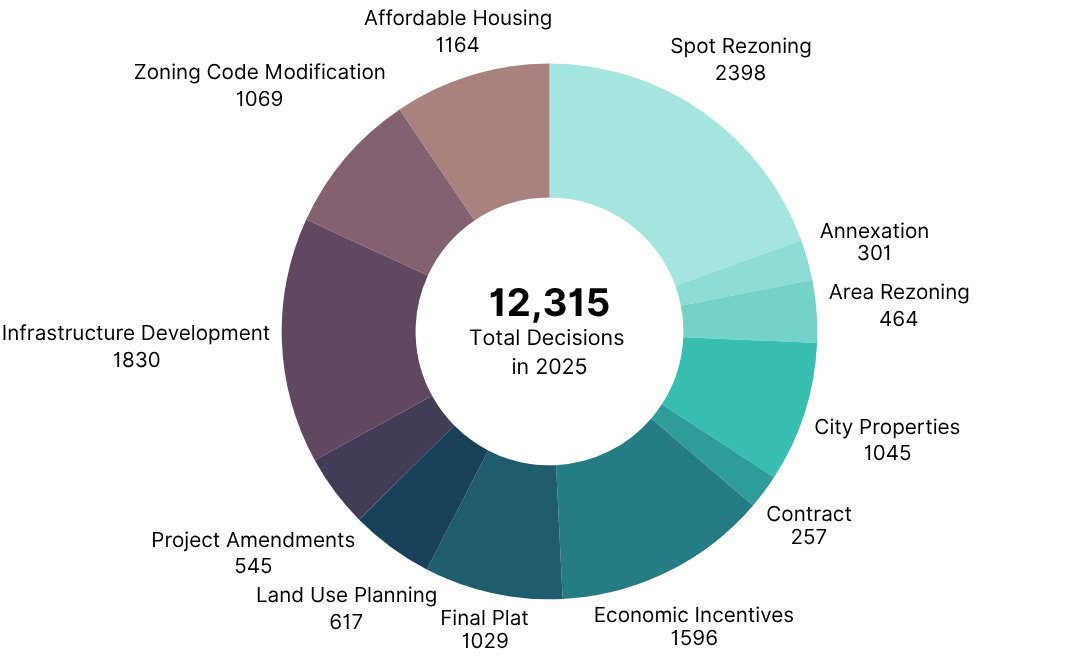What’s Happening in Local Land Use | Q3 2025
Tracking the past three months of notable local land use and zoning decisions
Real estate is—and will always be—a local business. The direction of our built environment is driven not by big decisions in Washington but by thousands of little decisions made every month by city councils and planning boards.
So we’ve partnered with ReZone on a quarterly feature capturing the most notable, impactful, and unique local land use decisions made over the past 90 days. The decisions offer a lens into where urban America is heading—and, just as importantly, where it’s not.
Todays’ letter will feature ADU liberalizations across the country, Maine’s new statewide housing bill, large-scale mixed-use plans, the biggest data center approvals, and a tiny-home project.
Let’s dive in.
Seattle Loosens ADUs Regulations
To comply with Washington State HB 1337, Seattle updated its standards for accessory dwelling units (ADUs) in all zones allowing single-family homes. The new citywide ADU regulations allow up to two ADUs per lot—attached or detached—in any configuration.
ADU size remains capped at 1,000 square feet, with exemptions for existing garages, bicycle parking, and exterior-access storage. Height limits align with each zone’s maximum building height (or 40 feet, whichever is less), with no alley setbacks required. Parking requirements and street improvement mandates are waived for ADU permits, and ADUs may be sold as condominium units.
This legislation was effective July 1st, 2025.
Seattle is one of many cities that has recently adopted new ADU regulations. The push towards encouraging more ADUs seems to stem primarily from statewide legislation changes. For example,
Oregon introduces ADUs through Senate Bill 391 (2021) being followed up by Bill 644 (2023),
Vermont’s Act 179 (2020) and HOME Act 47 (2023) made one ADU a permitted use within SFR zones and removed the need for a discretionary zoning permit (as well as reducing parking requirements, and decreasing other development standards),
Florida’s “Live Local Act”, specifically amended by Senate Bill 1730, introduced ADUs in all SFR zones (among many other things),
And then there’s always California, the forerunner for ADU legislation that has passed a flurry of ADU liberalizations including but not limited to SB 1211 (2025) to allow up to eight detached ADUs on MF properties, AB 2533 (2025) extending the state’s amnesty program for under permitted ADUs, AB 1033 (2024) allowing local jurisdictions to permit the separate sale of ADUs from the primary residence (treating them like condos), AB 976 (2024) eliminating owner-occupancy rules, and AB 1332 (2025) requiring that every city has a program for pre-approved ADU plans.
Maine also broadly legalized ADUs as part of the larger package of reforms we’ll discuss next.
Maine signs LD 1829 into Law
The landmark bill titled “An Act to Build Housing for Maine Families and Attract Workers to Maine Businesses by Amending the Laws Governing Housing Density”, was signed into law on June 20, 2025. The law introduces sweeping changes to zoning and land use regulations targeting density, lot size, and review processes.
Density
Municipalities are now required to permit at least three dwelling units per residential lot (attached or detached). If the lot is a designated growth area or is served by a public water & sewer district, then four dwelling units are allowed by right.
For affordable housing developments, where multifamily dwellings are permitted, the law mandates a density allowance of at least 2.5x the base density. Municipalities may not require more than 2 off-street parking spaces for every 3 units. Affordable housing developments must also be allowed to exceed local height restrictions by at least one story of 14 feet, subject to review by a fire official.
Review Processes
Municipalities are prohibited from requiring planning board approval for projects involving four or fewer dwelling units within a structure. All planning board members must attend mandatory training and “loopholes” commonly used by municipalities to avoid enacting statewide laws such as wastewater verification or subdivision thresholds have been simplified.
Other Changes
Maine also eliminated owner-occupancy mandates for ADUs, included a fire sprinkler exemption for ADUs, and introduced uniform dimensional standards (same setbacks, building heights, etc. for multiple-unit dwellings as single-family homes). The new law also mandated that minimum lot sizes in designated growth areas or sewer & water districts to not exceed 5,000 SF, with a density requirement of 1,250 SF per dwelling unit for the first four units.
Timeline
The provisions related to fire sprinklers, the ADU definition, and mandatory training apply immediately. For the core zoning and density changes, municipalities where ordinances can be enacted by municipal officers without a town vote must comply by July 1, 2026. All other municipalities have until July 1, 2027, to come into compliance.
Pittsburgh, PA reduces SFR minimum lot sizes
Pittsburgh, PA is reducing minimum lot sizes for all residential districts as part of Mayor Ed Gainey’s package of changes to the city's zoning code. The package was initially intended to include inclusionary zoning policies but has since been separated into individual ordinances so that every piece of the package must be voted on individually.
The new law decreases minimum lot sizes by an average of 40%. Setbacks, minimum lot area per dwelling unit, and other site development standards were adjusted accordingly. The city also increased maximum building heights in high-density (up to 85 feet) and very-high density (up to 180 feet) districts.

New York, Atlantic Avenue Mixed-Use Plan
The Atlantic Avenue Mixed-Use Plan will rezone about 21 city blocks in Brooklyn. This will allow for the creation of up to 4,600 new units, approximately 1,900 of which will be permanently affordable.
The city commits $115M for a comprehensive redesign of Atlantic Avenue’s bike lanes and traffic improvement projects at key intersections. They will also invest $100M for upgrades of six major open spaces, including Underhill Plaza/Lowry Triangle, St. Andrews Playground, Hancock Playground, Potomac Playground, Dean Playground, and James Forten Playground.
Data Center Approvals
Unprecedented demand for data centers continues to fuel new deliveries. Massive investments in projects such as the $100B investment through Stargate or the $20B investment by AWS into their Keystone & Susquehanna in Berwick, PA and Fairless, PA respectively. The latter represents the largest private project in Pennsylvania history.
J.P.Morgan estimates that data center spending could add 10-20 basis points to U.S. economic growth in 25-26. CBRE estimates that roughly 50% of all worldwide data center capacity is in the US and around 25% of those are in northern Virginia.
However, the push for new data center development and the NIMBY debate that comes with it has played out in city meetings across the country. Here are a few of the biggest data center approvals we tracked last quarter:
(1) Charlotte, NC approves Data Center Expansion
Charlotte approved a site plan amendment to previously approved I-2 (CD) zoning for a 156-acre site, allowing an increase from 1,5M SF to 3M SF of telecommunications and data storage facilities in up to two phases.
The site is close to I-85, Wilkinson Boulevard, and Charlotte-Douglas International Airport. Some of the key advantages stated are job creation and economic development.
(2) Hayward, CA OKs Three-Story, 310k SF Data Center Campus
The planning commission approved a 310,000 SF Data Center Campus located on 11 acres on the edge of town in its existing industrial zone. The single-owner project exceeds local and state sustainability requirements and promises job creation and economic growth for the community.
A generator yard with 28 diesel generators, an on-site substation and switching yard, and a direct evaporative cooling system as well as recycled-water-ready irrigation are included as well.
Belvoir Ranch is a 19,032-acre ranch located roughly 8 miles west from Cheyenne, WY. The new master plan organizes the ranch into four “character areas:” Recreation, Energy, History, and Opportunity.
The “opportunity” zone is prioritized for potential data center development, capitalizing on its vast, undeveloped acreage. Currently, the site hosts ~100 wind turbines, is surrounded by the Union Pacific Railroad tracks, and is used mainly for recreation.
The key hurdles stopping potential data center development include the lack of necessary infrastructure such as water, sewer, and high-capacity power lines.
While city ownership makes a large-scale development of this kind somewhat easier, the site currently lacks necessary infrastructure like water, sewer, and high-capacity power lines.
Using small lots to build tiny homes with big impact
In a move to address housing affordability and support at-risk young adults, the Colorado Springs City Council approved the rezoning of a 0.78-acre parcel to allow for a "Tiny House Community". The project will feature 18 single-story tiny homes, each around 330 square feet, along with a community building and shared green space. To make the project viable, the city approved adjustments to development standards, including reduced setbacks and parking requirements.
The parcel was rezoned from a R-5 (Multi-Family High) to R-Flex High. A conditional use and development plan for a tiny house community and several adjustments to development standards were included as well. The Parcel was bought for $470,000 on 4/26/2024 and contained a SFR.
Thanks to ReZone for these insights and recurring Thesis Driven feature!
—Daniel Heller













